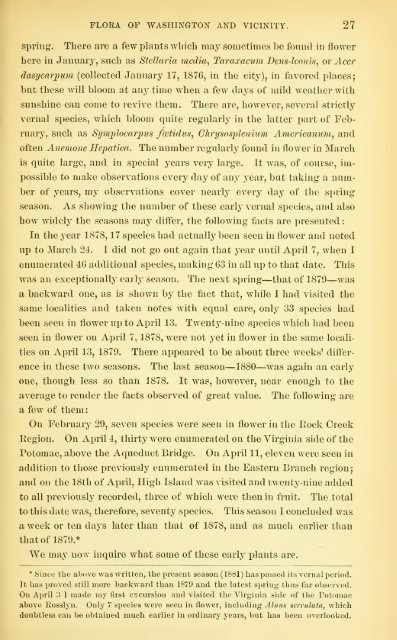Bulletin - United States National Museum - Smithsonian Institution
Bulletin - United States National Museum - Smithsonian Institution
Bulletin - United States National Museum - Smithsonian Institution
You also want an ePaper? Increase the reach of your titles
YUMPU automatically turns print PDFs into web optimized ePapers that Google loves.
:<br />
FLORA OF WASHINGTON AND VICINITY, 27<br />
spring. There are a few plants which may sometimes be found in flower<br />
here in January, such as Siellaria media, Taraxaciim Dens-leonis, or Acer<br />
dasycarpum (collected January 17, 1876, in the city), in favored places;<br />
but these will bloom at any time when a few days of mild weather with<br />
sunshine can come to revive them. There are, however, several strictly<br />
vernal species, which bloom quite regularly in the latter part of Feb-<br />
ruary, such as Symplocarpus fcetidus, Chrysosplenium Americanum, and<br />
often Anemojie Hepatica. The number regularly found in flower in March<br />
is quite large, and in special years very large. It was, of course, im-<br />
possible to make observations every day of any year, but taking a num-<br />
ber of years, my observations cover nearly every day of the spring<br />
season. As showing the number of these early vernal species, and also<br />
how widely the seasons may differ, the following facts are presented<br />
In the year 1878, 17 species had actually been seen in flower and noted<br />
up to March 24. I did not go out again that year until April 7, when I<br />
enumerated 46 additional species, making 63 in all up to that date. This<br />
was an exceptionally early season. The next spring—that of 1879—was<br />
a backward one, as is shown by the fact that, while I had visited the<br />
same localities and taken notes with equal care, only 33 species had<br />
been seen in flower up to Ai)ril 13. Twenty-nine species which had been<br />
seen in flower on April 7, 1878, were not yet in flower in the same locali-<br />
ties on April 13, 1879. There appeared to be about three weeks' differ-<br />
ence in these two seasons. The last season—1880—was again an early<br />
one, though less so than 1878. It was, however, near enough to the<br />
average to render the facts observed of great value. The following are<br />
a few of them<br />
On February 29, seven species were seen in flower in the Eock Creek<br />
Region. On Aj^ril 4, thirty were enumerated on the Virginia side of the<br />
Potomac, above the Aqueduct Bridge. On April 11, eleven were seen in<br />
addition to those previously enumerated in the Eastern Branch region;<br />
and on the 18th of April, High Island was visited and twenty-nine added<br />
to all previously recorded, three of which were then in fruit. The total<br />
to this date was, therefore, seventy species. This season I concluded was<br />
a week or ten days later than that of 1878, and as much earlier than<br />
that of 1879.*<br />
We may now inquire what some of these early plants are.<br />
* Since the above was written, the present season (1881) has passed its vernal period.<br />
It has proved still more backward than 1879 and the latest spring thus far observed.<br />
On April 3 I made my first excursion and visited the Virginia side of the Potomac<br />
above Rosslyn. Only 7 species were seen in flower, including Alnus serrulata, which<br />
doubtless can be obtained much earlier in ordinary years, but has been overlooked.<br />
:

















